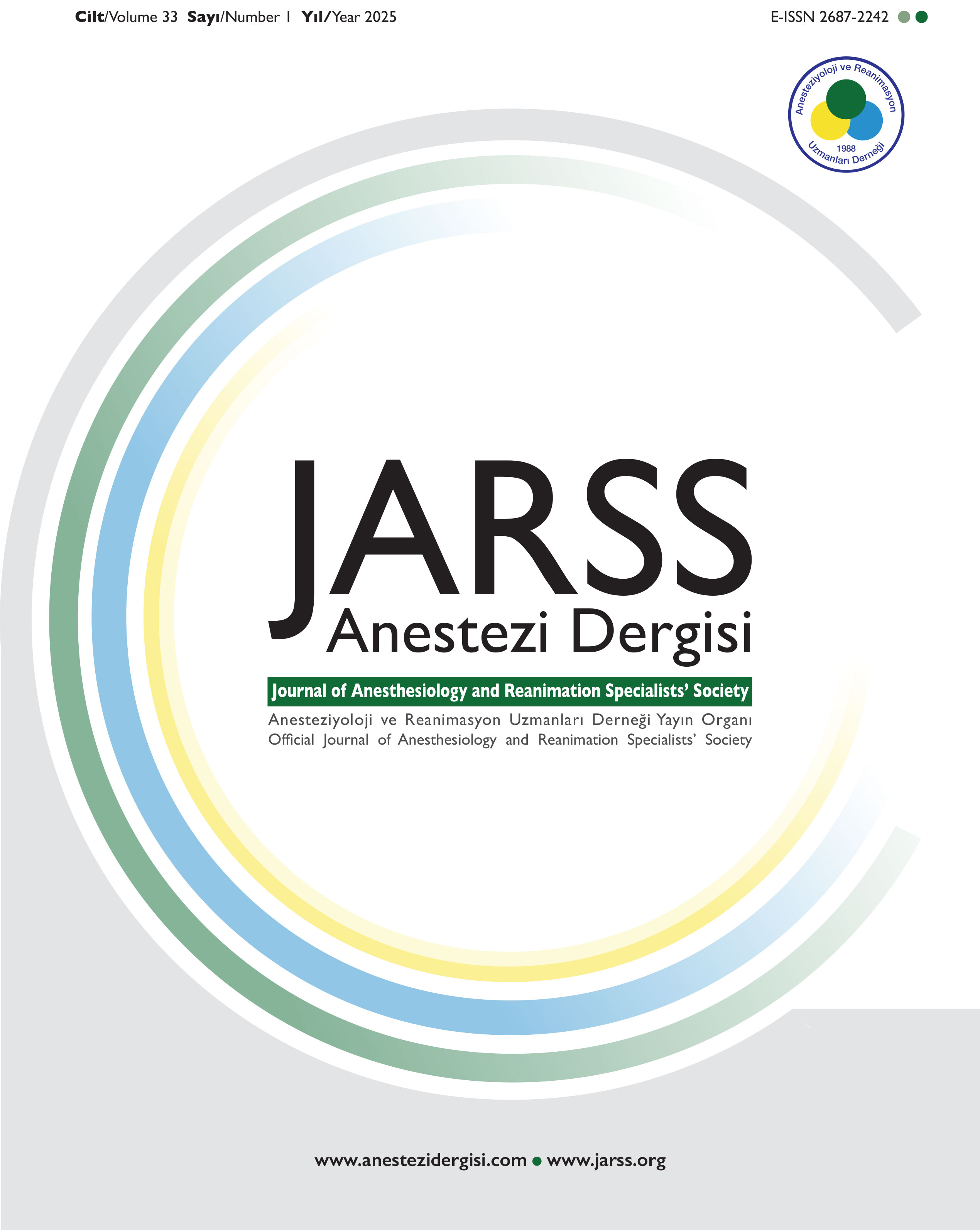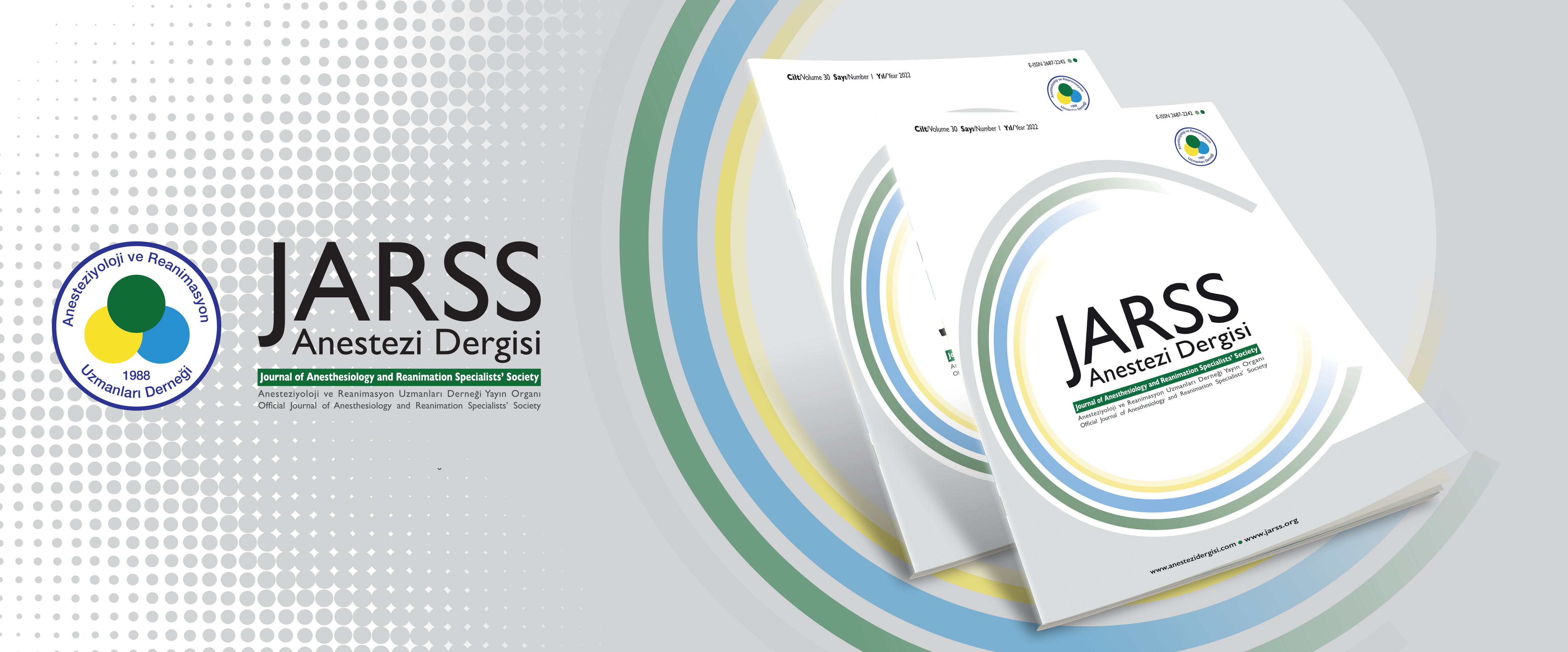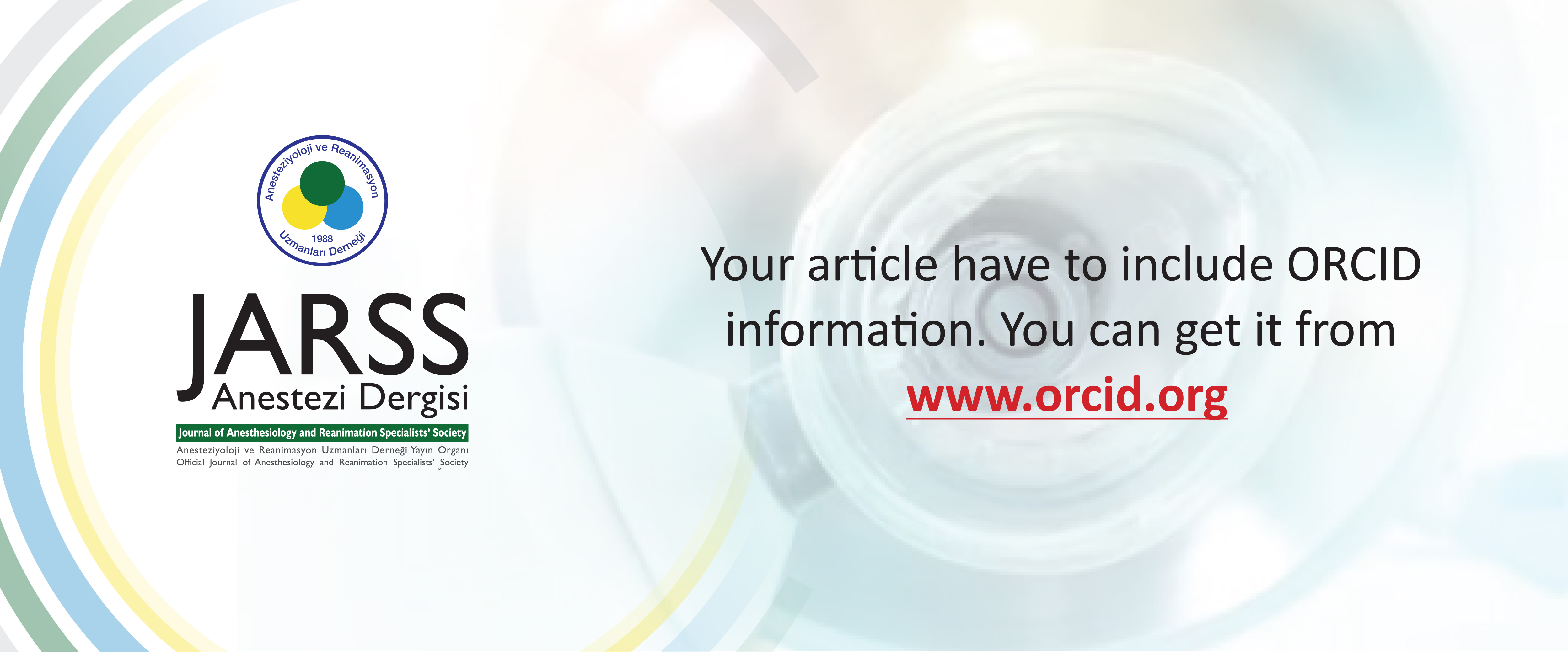Volume: 30 Issue: 3 - 2022
| 1. | Cover Page I (380 accesses) |
| 2. | Advisory Board Pages II - V (456 accesses) |
| 3. | Contents Pages VI - VII (321 accesses) |
| REVIEW | |
| 4. | Anesthesia Management for Craniosynostosis Surgery Onur Özlü doi: 10.54875/jarss.2022.69370 Pages 163 - 170 (1490 accesses) Craniosynostosis is premature fusion of one or more cranial sutures. In isolated craniosynostosis, surgical procedures are applied to ensure normal brain development and normal cognitive functions, to correct cosmetic deformities in order to prevent psychosocial negative consequences. The fact that they are mostly infants, combined with significant blood loss in the perioperative period, makes these cases challenging for the anesthetist. Ensuring airway safety, coping with metabolic complications related to blood transfusions and infusion of electrolyte fluids, preventing hypothermia, postoperative pain management, treatment of nausea and vomiting are the main subjects of anesthesia management. Excellent results can be obtained with proper preoperative planning, monitoring and timely blood and fluid infusion. |
| ORIGINAL RESEARCH | |
| 5. | The Effect of Ultrasound-Guided Transversus Abdominis Plane Block on Chronic Pain Experienced After Inguinal Hernia Surgery: A Retrospective Cohort Study Fatih Şimşek, Gökhan Özkan doi: 10.54875/jarss.2022.97752 Pages 171 - 175 (497 accesses) Objective: The purpose of this retrospective study was to see how efficient ultrasound-guided transversus abdominis plane (TAP) block was on the incidence of chronic postoperative pain developing after inguinal hernia surgery. Methods: The records of patients who had unilateral elective grafted inguinal hernia surgery with the Lichtenstein procedure under general anesthesia between July 2018 and October 2019 were examined retrospectively. The patients were placed into two groups (total=70): those who did not receive intraoperative TAP block (Group 1, n=38) and those who received (Group 2, n=32). The patients were contacted by phone 6 months after the procedure, and it was learned and recorded whether they had chronic pain before the operation, the nature of the pain if any, whether it limited their daily activities or not. The Numerical Rating Scale was used to measure chronic pain, and values of 3 and above were considered chronic pain. Results: This study comprised a total of 70 participants, with 38 patients in Group 1 and 32 patients in Group 2. Patients with chronic pain incidence in the postoperative 6th month (n=21) accounted for 30% of all patients. There was no significant difference between the groups regarding chronic pain development [Group 1 (n=14, 36.8% ), Group 2 (n=7, 21.8%)]. It was observed that the patients’ pain was predominantly in the burning style. Conclusion: We concluded that the ultrasound-guided TAP block had no significant effect on the development of chronic pain. |
| 6. | Vibration Anesthesia for Propofol-Rocuronium Injection Pain Aygün Güler, Namık Nebi Özcan doi: 10.54875/jarss.2022.03274 Pages 176 - 181 (718 accesses) Objective: Despite numerous strategies for preventing or alleviating pain associated with propofol and rocuronium injections, it remains common and distressing for patients. Application of vibration is an effective method of reducing pain during facial cosmetic injections and some venipuncture procedures. But it has been studied in limited trials for the context of propofol or rocuronium injection pain. This randomized study aims to evaluate the effect of vibration anesthesia on the incidence and severity of propofol and rocuronium injection pain. Methods: Fifty-one patients who underwent elective gynecologic operations under general anesthesia, were randomized, into two groups. On the dorsal side of the hand, a 20 G intravenous cannula was inserted. In Group V (n=25), propofol and rocuronium was administered following 1 minute of pre-treatment with the vibration device on the intravenous catheter trace. In Group C (n=26) vibration was not applied before drug administration. Propofol pain was recorded according to McCrirrick and Hunter scale and rocuronium injection pain response was evaluated with a four-point scale. Results: The number of patients who experienced propofol injection pain, in the vibration group was significantly lower than in the control group (p=0.007). The percentage of pain free patients in Group V was 88%, whereas 46% in Group C. The incidence of withdrawal movements associated with rocuronium injection pain was also significantly lower in Group V (p=0.043). Percentage of pain free patients in Group V was 28% whereas 3.8% in Group C. Conclusion: Vibration anesthesia before propofol and rocuronium injection significantly reduced the injection pain. |
| 7. | Does Leg Raising Prevent Spinal-Induced Hypotension in Elective Cesarean Sections? A Randomized Controlled Study Mustafa Deniz Sarı, Erhan Özyurt doi: 10.54875/jarss.2022.25348 Pages 182 - 187 (509 accesses) Objective: We aimed to investigate the effectiveness of the leg raising (LR) method in preventing spinal anesthesia-induced hypotension in elective cesarean section (C/S) operations. Methods: One hundred and forty term pregnant women were included in the study. The patients were divided into two groups as leg raising group (Group L, n=70) and the control group (Group C, n=70). After spinal anesthesia, a cushion was placed under the heels of the patients in Group L at an angle of 30 degrees with the horizontal plane. No intervention was made in Group C. The patients’ hemodynamic and operation data were recorded at determined intervals. Results: In Group L, hypotension was observed in 29 (41.4%) patients while 54 (77.1%) patients developed hypotension in Group C (p<0.001). Systolic and diastolic blood pressure values at the 2nd and 3rd minutes after spinal anesthesia were found to be higher in Group L (p<0.05). Furthermore, compared to Group C, the amount of ephedrine used in Group L was found to be lower (9.9±14.2 mg vs. 15.9±11.9 mg, p=0.007). Conclusion: The LR method applied in C/S operations reduces spinal anesthesia-induced hypotension and thus causes the need for less vasopressor. |
| 8. | Effect of the Lumbar Sympathetic Block on Pain in Patients with Symptomatic Peripheral Arterial Disease-Retrospective Analysis Samet Sancar Kaya, Şeref Çelik, Erkan Yavuz Akçaboy, Hamit Göksu, Mustafa Yemliha Ayhan, Saziye Şahin doi: 10.54875/jarss.2022.58076 Pages 188 - 192 (1277 accesses) Objective: To study the effect of lumbar sympathetic block (LSB) with a mixture of local anesthetics and steroids on pain in patients with chronic ischemic lower limb disease. Methods: Retrospectively 23 patients were reviewed with peripheral arterial disease who underwent LSB using a mixture of 8 mg of dexamethasone, 80 mg of 2% lidocaine, and 4 mL of saline at 2 levels, L2 and L4, under the guidance of fluoroscopy. Recordings of the Visual Analog Scale (VAS) scores at 3 days before the blockage, and 1 month and 3 months after treatment were obtained. Results: The study included 20 (87%) male and 3 (13%) female patients. The mean age of the patients was 59.65±13.33 years. The patients’ post-blockage 3rd day, and 1st and 3rd month VAS scores were significantly lower than the baseline VAS scores (p<0.05). The proportion of patients with 50% improvement in the VAS scores at 3rd days, and 1st and 3rd months was 47.8%, 21.7%, and 21.7%, respectively. No complications or side effects were observed. Conclusion: Lumbar sympathetic block with a mixture of local anesthetics and steroids appears to be effective in patients who have non-reconstructable arterial occlusive disease, with reduced pain scores and low complication rates. |
| 9. | The Effects of Fresh Gas Flow on Emergence Agitation for Gynecologic Surgery: A Clinical Study Ayça Taş Tuna, Gürkan Demir, Havva Kocayiğit, Ali Fuat Erdem doi: 10.54875/jarss.2022.71677 Pages 193 - 198 (755 accesses) Objective: This prospective study aimed to determine whether low flow anesthesia (LFA) has an effect on emergence agitation in women who underwent laparotomic gynecologic surgeries. Method: Sixty four female patients were enrolled in this prospective randomized study. The patients were randomly allocated into two groups: Group 2 and Group 0.5. The fresh gas flow (FGF) rate was set at 4 L min⁻¹ in both groups, initially. When all patients reached 1 minimum alveolar concentration of sevoflurane, the FGF rate was reduced to 2 L min⁻¹ in Group 2 and 0.5 L min⁻¹ in Group 0.5. For Group 0.5, vapor was closed 15 minutes before the end of surgery, while it was closed at the end of the operation for Group 2. At the end of the surgery, the FGF rate was increased to 4 L min⁻¹. Emergence agitation was assessed using the Riker Sedation Agitation Scale (SAS) in the post-anesthesia care unit at 5, 10, 20 and 30th minutes. Results: Emergence agitation was observed in 5 patients, no significant difference was found between two groups. For all evaluation times, number of patients with SAS=4 was significantly higher in Group 0.5, while the number of patients with SAS<4 was significantly higher in Group 2 (p<0.05). Conclusion: The number of patients who are calm and cooperative was higher in LFA. |
| 10. | A Comparative Study of the Effectiveness of Lumbar Steroid Injection in Kambin’s Triangle Versus Conventional Transforaminal Approach for the Treatment of Lumbar Radicular Pain: A Prospective Randomised Study Gauresh Singh, Reena Dr, Anil Kumar Paswan, Amrita Rath doi: 10.54875/jarss.2022.28199 Pages 199 - 206 (486 accesses) Objective: Low back pain is a very troublesome and common issue among patients irrespective of age and sex and is very difficult to manage with conservative management. It can lead to disability and mental issues. Methods: After ethical committee approval, a prospective, randomised, double-blind comparative study on 40 patients aged 20-70 years, suffering from lumbar radicular pain was carried out by two different approaches i.e., conventional transforaminal and Kambin’s triangle approach and epidural steroids were administered. Change in pain intensity using the Verbal Numerical Rating Scale was recorded as our primary outcome. Change in functional status using Oswestry Disability Index and Patient Satisfaction Score were our secondary outcomes. Any adverse event, complication, failure was also noted. Results: Multiple logistic regression showed no difference in pain relief or improvement of functional status due to variable differences like the age, sex, disc level or the type of approach. Conclusion: Both approaches of transforaminal epidural steroid injection were effective in reducing pain and increasing functional status significantly. There was no significant difference in their effectiveness and neither was superior to the other. |
| LETTER TO THE EDITOR | |
| 11. | Nonconvulsive Status Epilepticus After Endovascular Intervention for a Non-Ruptured Intracranial Aneurysm: A Very Rare Case Pınar Ergenoğlu doi: 10.54875/jarss.2022.84803 Pages 207 - 208 (417 accesses) Abstract | |
| NOTE | |
| 12. | After Euroanaesthesia 2022 Selin Erel doi: 10.54875/jarss.2022.38980 Pages 209 - 211 (353 accesses) Abstract | |
| 13. | Retired ARUD Presidents Page 212 (403 accesses) Abstract | |

















